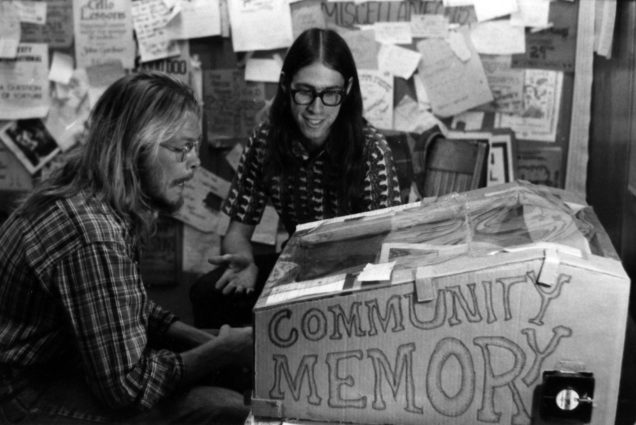As the teleprinter was first invented by engineers, inventors and users in 1830s would never imagine that this technology could be evolved to something that could easily allow users to instantly “exchange small elements of content such as short sentences, individual images, or video links(Kaplan & Haenlein, 2011)”, that is, the microblogging. Back to the 19th century, teleprinters were invented in order to send and receive messages without the need for operators trained in the use of Morse code, and the system improved message speed and delivery time, making it possible for messages to be flashed across a country with little manual intervention. Then, in 1973, the first public computer-based bulletin board system(BBS) — Community Memory — was created in California by using a timesharing system connected via a link to a teleprinter at Leopold’s record store to let users enter and retrieve messages. At that time, individuals could place messages in the computer and then look through the memory for a specific notice. More than twenty years later, the term “weblog” was coined by Jorn Barger and popularized in 21th centry, becoming the evolutionary digital community of BBS, and functioning either as personal online diaries, or as a form of social networking service based on web 2.0 technology that allows visitors to leave online comments and forms a innovative way of interactivity.

As time goes by, microblogging, a form of blogging with the main difference being siginificant limits on the length of posts was emerged. As wikipedia defined, microbloggers post about topics ranging from the simple, such as “what I’m doing right now,” to the thematic, such as “sports cars.” However, the term “microblogging” is not frequently used in conversation; instead, people typically refer to the name of the microblogging platform — Twitter. It was founded by Jack Dorsey in 2006, has rapidly become one of the major players in the social media industry. According to Twitter, from the first Tweet to the billionth Tweet, it took them only 3 years, 2 months and 1 day. The number of Twitter accounts reached 75 million by the end of 2009, with a growth rate of approximately 6.2 million new users per(Kaplan & Haenlein, 2011).
In the first quarter of 2017, Chinese microblogging platform Sina Weibo has announced it had 340 million active monthly users, overtaking Twitter in active user totals, among the worldwide most popular social networks services. My example of the influence of social network is based on the Sina Weibo platform — the “revolutionary” technology of teleprinter. In April of 2011, Fei Deng, an investigative journalist who was well known for his anti-corruption reports and online activism on Weibo (e.g. he was leading a combat child-trafficking campaign before), together with hundreds of journalists, launched a public fund-raising campaign, called the “Free Lunch for Children”(FLFC), by setting up kitchens in schools in poor areas to provide fresh hot meals on to poverty-stricken children, and calling for the public to donate about $0.5 for each free lunch. According to the FLFC’s official statistics, from its initiation to the end of August 2017, this program had raised 5 billion dollars, and found its presence in 893 schools.

In the course of the successful operation of FLFC, Weibo, connected to other technologies like online payment system, blogs, and traditional media, opens up a plethora of channels to promote FLFC, to encourage participation and to mobilise resources from all corners of society, played a significant role in conducting a distributed collaboration, framing collective actions, and also establishing legitimacy — enforcing transparency(Zheng & Yu, 2016), and even promoted the promulgation of improvement of nutrition plan for students on rural compulsory education in China. For example, the FLFC program formed an alliance with a wide range of actors to construct and expand network across time and space, and mobilising resources through a variety of channels, often mediated by Weibo. Also, the @ sign allows senders to notify specific receivers to their posts on Weibo, thereby raising their attention and signals an invitation for participation. In the meanwhile, FLFC strategically adopted Weibo and other linked platforms to promote the issue of child hunger to the public. On social media, users are not only receivers, but more importantly active transmitters, diffusors and generators. In that sense, elites and activists such as the founder of FLFC are able to perform agenda-setting by enacting the viral information diffusion function of the internet, in particular the interactivity and connectivity of Weibo.
To the aspect of more recent developments in wearable devices, online-social-mobile communication technologies will evolve into more instant, visualized and portable technologies, e.g., the future Weibo user who participated in FLFC program may be able to post 360 videos of fresh hot meals and the smile of children, and also record the school’s location by clicking the button on the augmented reality glasses, in order to help other users recreate the environment and fully participate in the movement.
As for me, in the very Hauberian sense that the essence of the Net is communication, the contemporary stage of online-social-mobile media (e.g., Weibo and WeChat) enables me to hear voices from different factions and get informations from participants who are stragers, and also build my social networks through daily communication with the real person in real life.
In the formation of the modern Internet era, the “hacker-geek” culture act as a catalyst. Contrary to previous argument, according to Paul Graham, the founder of Viaweb and Y Combinator, “hackers are makers, like painters or architects or writers,” trying to make good things. And the way to create something beautiful is often to make subtle tweaks to something that already exists, or to combine existing ideas in a slightly new way(Graham, 2004). In addition, many of the values and tenets of the free and open source movement — a critical element of modern software — stem from the hacker ethics(Levy, 1984). On the one hand, the availability of an open source software can increase adoption of its standard and offers a more flexible technology and quicker innovation(e.g., the Linux operating system), however, it also poses a threat to the security and stability, which are the two lifelines of a software. For the social network aspect, it is too danger to a facebook or twitter user whose data being hacked with ill intention, as people almost expose every details of living on the online social network services.
References
Doub, B. (2016, February 23). Community Memory: Precedents in Social Media and Movements. Retrieved from http://www.computerhistory.org/atchm/community-memory-precedents-in-social-media-and-movements/.
Graham, P. (2004). Hackers & painters: big ideas from the computer age. Sebastopol, CA: O’Reilly. ISBN 0-596-00662-4.
Kaplan, A.M. & Haenlein, M. (2011). The early bird catches the news: Nine things you should know about micro-blogging. Business Horizons, 54(2), 105-113. doi:10.1016/j.bushor.2010.09.004.
Levy, S. (1984). Hackers: Heroes of the Computer Revolution. Garden City, NY: Nerraw Manijaime/Doubleday. ISBN 0-385-19195-2
Twitter user numbers overtaken by China’s Sina Weibo. (2017, May 17). In BBS News. Retrieved from http://www.bbc.com/news/technology-39947442.
Typewriter May Soon Be Transmitter of Telegrams. (1914, January 25). In The New York Times. Retrieved from http://query.nytimes.com/mem/archive-free/pdf?res=9807E3DE1E39E633A25756C2A9679C946596D6CF
Zheng, Y., & Yu, A. (2016) Affordances of social media in collective action: the case of Free Lunch for Children in China. Information Systems Journal, 26(3), 289–313. doi: 10.1111/isj.12096.
